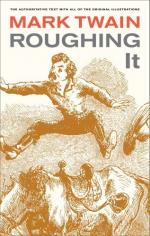Passing through the market place we saw that feature of Honolulu under its most favorable auspices—that is, in the full glory of Saturday afternoon, which is a festive day with the natives. The native girls by twos and threes and parties of a dozen, and sometimes in whole platoons and companies, went cantering up and down the neighboring streets astride of fleet but homely horses, and with their gaudy riding habits streaming like banners behind them. Such a troop of free and easy riders, in their natural home, the saddle, makes a gay and graceful spectacle. The riding habit I speak of is simply a long, broad scarf, like a tavern table cloth brilliantly colored, wrapped around the loins once, then apparently passed between the limbs and each end thrown backward over the same, and floating and flapping behind on both sides beyond the horse’s tail like a couple of fancy flags; then, slipping the stirrup-irons between her toes, the girl throws her chest for ward, sits up like a Major General and goes sweeping by like the wind.
The girls put on all the finery they can on Saturday afternoon—fine black silk robes; flowing red ones that nearly put your eyes out; others as white as snow; still others that discount the rainbow; and they wear their hair in nets, and trim their jaunty hats with fresh flowers, and encircle their dusky throats with home-made necklaces of the brilliant vermillion-tinted blossom of the ohia; and they fill the markets and the adjacent street with their bright presences, and smell like a rag factory on fire with their offensive cocoanut oil.
Occasionally you see a heathen from the sunny isles away down in the South Seas, with his face and neck tatooed till he looks like the customary mendicant from Washoe who has been blown up in a mine. Some are tattooed a dead blue color down to the upper lip—masked, as it were —leaving the natural light yellow skin of Micronesia unstained from thence down; some with broad marks drawn down from hair to neck, on both sides of the face, and a strip of the original yellow skin, two inches wide, down the center—a gridiron with a spoke broken out; and some with the entire face discolored with the popular mortification tint, relieved only by one or two thin, wavy threads of natural yellow running across the face from ear to ear, and eyes twinkling out of this darkness, from under shadowing hat-brims, like stars in the dark of the moon.
Moving among the stirring crowds, you come to the poi merchants, squatting in the shade on their hams, in true native fashion, and surrounded by purchasers. (The Sandwich Islanders always squat on their hams, and who knows but they may be the old original “ham sandwiches?” The thought is pregnant with interest.) The poi looks like common flour paste, and is kept in large bowls formed of a species of gourd, and capable of holding from one to three or four gallons. Poi is the chief article of food among the natives, and is prepared from the taro plant.




